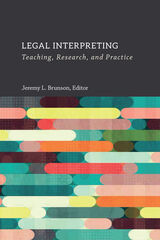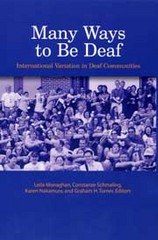2 books by Turner, Graham H.

Legal Interpreting
Teaching, Research, and Practice
Jeremy L. Brunson
Gallaudet University Press, 2022
Linguistic minorities are often severely disadvantaged in legal events, with consequences that could impact one’s very liberty. Training for interpreters to provide full access in legal settings is paramount. In this volume, Jeremy L. Brunson has gathered deaf and hearing scholars and practitioners from both signed and spoken language interpreting communities in the United States, Canada, and the United Kingdom. Their contributions include research-driven, experience-driven, and theoretical discussions on how to teach and assess legal interpreting. The topics covered include teaming in a courtroom, introducing students to legal interpreting, being an expert witness, discourses used by deaf lawyers, designing assessment tools for legal settings, and working with deaf jurors. In addition, this volume interrogates the various ways power, privilege, and oppression appear in legal interpreting.
Each chapter features discussion questions and prompts that interpreter educators can use in the classroom. While intended as a foundational text for use in courses, this body of work also provides insight into the current state of the legal interpreting field and will be a valuable resource for scholars, practitioners, and consumers.
Each chapter features discussion questions and prompts that interpreter educators can use in the classroom. While intended as a foundational text for use in courses, this body of work also provides insight into the current state of the legal interpreting field and will be a valuable resource for scholars, practitioners, and consumers.
[more]

Many Ways to Be Deaf
International Variation in Deaf Communities
Leila Monaghan
Gallaudet University Press, 2003
The recent explosion of sociocultural, linguistic, and historical research on signed languages throughout the world has culminated in Many Ways to Be Deaf, an unmatched collection of in-depth articles about linguistic diversity in Deaf communities on five continents. Twenty-four international scholars have contributed their findings from studying Deaf communities in Japan, Thailand, Viet Nam, Taiwan, Russia, Sweden, Austria, Switzerland, Great Britain, Ireland, Nigeria, South Africa, Brazil, Nicaragua, and the United States. Sixteen chapters consider the various antecedents of each country’s native signed language, taking into account the historical background of their development and also the effects of foreign influences and changes in philosophies by the larger, dominant hearing societies.
The remarkable range of topics covered in Many Ways to Be Deaf will fascinate readers, from the evolution of British fingerspelling traced back to the 17th century; the comparison of Swiss German Sign Language with Rhaeto-Romansch, another Swiss minority language; the analysis of seven signed languages described in Thailand and how they differ in relation to their distance from isolated Deaf communities to Bangkok and other urban centers; to the vaulting development of a nascent sign language in Nicaragua, and much more. The diversity of background and training among the contributors to Many Ways to Be Deaf distinguishes it as a genuine and unique multicultural examination of the myriad manifestations of being Deaf in a diverse world.
[more]
READERS
Browse our collection.
PUBLISHERS
See BiblioVault's publisher services.
STUDENT SERVICES
Files for college accessibility offices.
UChicago Accessibility Resources
home | accessibility | search | about | contact us
BiblioVault ® 2001 - 2024
The University of Chicago Press









